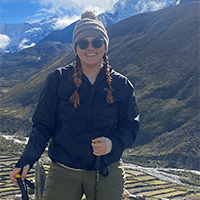Acute Intermittent Porphyria (AIP)

Nancy Pometta experienced her first Acute Intermittent Porphyria (AIP) while hiking the great Mount Everest. Nancy lives in Seattle, Washington where for last ten years, she suffered with abdominal pain and vomiting. Despite her many referrals to a GI doctor, the physicians all agreed that she had a dietary issue.. life was about to change.
Then in September 2023, she traveled to Nepal to climb on Mount Everest Toward the end of the trek, Nancy had severe leg pain and became so weak she wanted to get home. She returned to Katmandu and readed herself as best she could while continuing the extreme pain and vomiting. Traveling back to the USA was horrific.
Once home, she worsened. After waking from a nap, she couldn’t stand. Her legs collapsed and she was rushed to the hospital. Nancy continued to weaken until paralysis overcame her. Her sodium was dangerously low and her blood pressure was dangerously high. She was placed in the ICU.
Two days later, she was transferred to a different hospital where she remained for two months. For four more months her legs and arms wouldn’t work. Doctors thought Nancy had Guillain Barre disease but finally, when she got worse instead of better, the GB diagnosis was swept aside.
Nancy was in misery and crying herself to sleep sure that she was dying.
She had just taken off work for a month and shared she would be back soon. Instead, she remained in the hospital for four months of therapy...It was difficult for her to come back from the therapy. Her legs would not work. But on October 2 at 10 PM, doctors came into her hospital room and woke her from a deep sleep and said, “We have a diagnosis---AIP . This occurred two hours before her 30th Birthday!!! She promptly received her first Panhematin infusion and commented that the Panhematin was the best birthday present anyone could ever have as her back and abdominal pain began to leave immediately.
Later, she was told how the diagnosis was reached. When the doctors saw her urine, they thought it was filled with blood. The tests clearly showed the reddish brown in her urine was NOT blood. An internist commented, I saw this color urine in medical school.” She quickly ordered a urine PBG test, which was very elevated. The doctor knew she had the answer.
Once the medical team began the Panhematin infusions, the healing began though very slow. Her muscles had atrophied so she still had to deal with intense therapy. She also had to continue her Panhematin infusions to prevent more attacks. Thankfully, the infusions kept the horrendous pain at bay. She maintained the physical therapy and the Panhematin until she was finally able to return to normal life and work. It continued to be challenging
In 2024 she was able to return to work. But work was fraught with more than just long hours, she also had taunts from her colleagues. Because she looked well, they did not believe she had endured the grave life threatening situation she had encountered. Although the barbs were hurtful, Nancy overcame them, too. Her less than warm experience upon returning to work helped her make the decision to try to help other patients any way possible.
Nancy will soon be appearing on the APF Podcast to tell her full story. Tune in to the Rarely Discussed, the APF Podcast to watch Nancy’s story and those of many other porphyria friends, doctors and caretakers.


